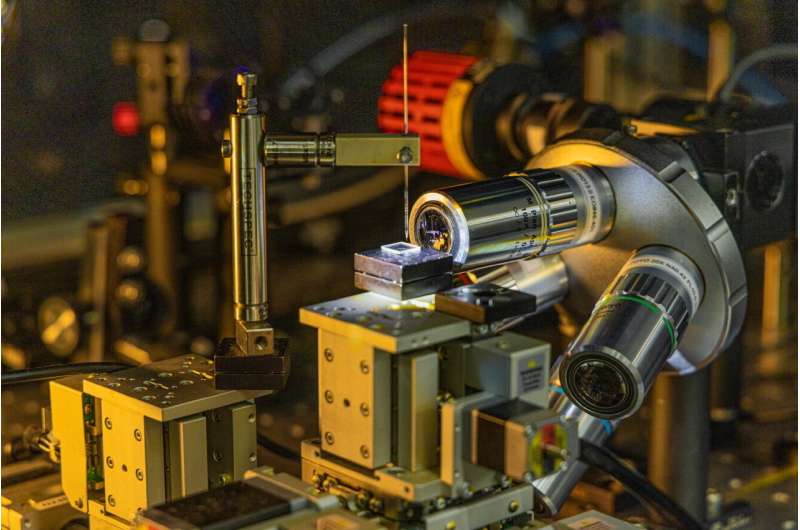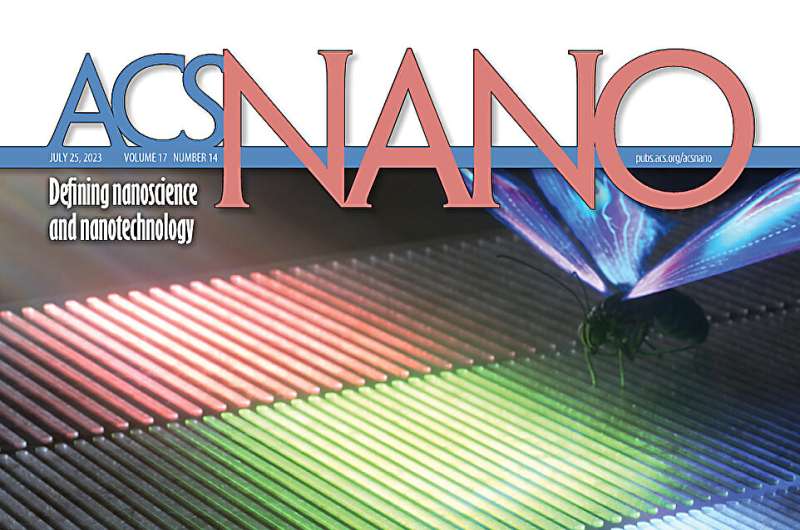This article has been reviewed according to Science X's editorial process and policies. Editors have highlighted the following attributes while ensuring the content's credibility:
fact-checked
peer-reviewed publication
proofread
3D printing technology achieves precision light control for structural coloration

The world's first 3D printing technology that can be used in transparent displays and AR devices has been developed, which implements the physical phenomenon of chameleon's changing skin color or peacock's beautiful feather color.
Dr. Jaeyeon Pyo's team at KERI has succeeded in realizing a three-dimensional diffraction grating that can precisely control the path of light based on "nanoscale 3D printing technology." This is a novel technology that can utilize the principle of structural color observed in nature for advanced display technology. The research was published as a cover article in ACS Nano.
When light encounters a microstructure at the wavelength level (1/100 to 1/1000 of the thickness of a human hair), it diffracts and changes its path. In cases where the microstructure possesses reularity, specific wavelengths of light undergo strong reflection due to diffraction, resulting in distinct colors known as "structural color."
For instance, in nature, the skin color of chameleons doesn't arise from a mixture of multiple pigments; rather, it emerges from changes in the microstructure, which lead to the production of structural colors. Similarly, the beautiful colors seen in peacock feathers are a result of the specific arrangement of their internal microstructure.
KERI's achievement is the realization of "diffraction grating," which can precisely control structural color, with nanoscale 3D printing technology. A diffraction grating is a device with a regularly arranged microstructure for the purpose of controlling the diffraction of light. When light is shined on it, the light is reflected in different paths depending on the wavelength, creating a specific structural color or spectrum. In other words, it is a 3D printing technology that enables precise control of light for vivid coloration without dyes.
A very fine diffraction grating is needed to control the diffraction of light whose wavelength is only 1/1000th the thickness of a human hair. KERI, which has the world's best nanoscale 3D printing technology, succeeded in printing high-density nanowire diffraction gratings with a new approach called "lateral printing." This is done by moving the 3D printing nozzle as if it were sewing to print the bridge shape(﹇).

The demonstrated diffraction grating is expected to be used in a variety of advanced display applications. Noting the transparency of the diffraction grating itself, it can be used in a variety of future transparent displays such as smart windows, mirrors, and heads-up displays in automobiles.
There are also many applications for this technology in AR devices that already utilize diffraction gratings as a key component. Furthermore, diffraction gratings can be designed to emit different colors depending on their deformation, making the technology usable in mechanical engineering and biomedical applications where deformation detection is required, and the diffraction grating itself can be used in a variety of optical physics research.
Dr. Jaeyeon Pyo of KERI said that this is "the world's first 3D printing technology that accurately implements the desired structural color in the desired location without restrictions on the material or shape of the substrate." He added that this technology will be able to overcome the formulaic "Form-Factor" limitations of display devices and bring about diversification of shapes.
KERI, which has completed the patent application of the original technology, expects this achievement to receive a lot of attention from display-related companies, and plans to promote technology transfer by identifying companies that need this technology.
More information: Jongcheon Bae et al, Three-Dimensional Printing of Structural Color Using a Femtoliter Meniscus, ACS Nano (2023). DOI: 10.1021/acsnano.3c02236
Journal information: ACS Nano
Provided by National Research Council of Science & Technology



















